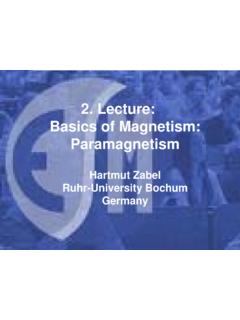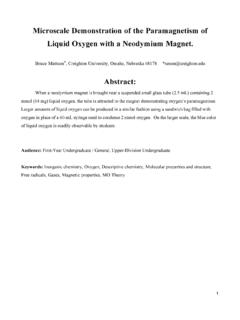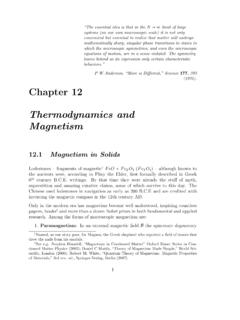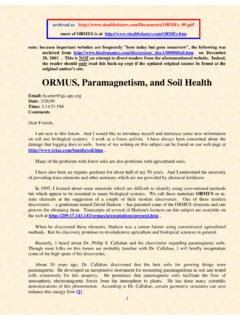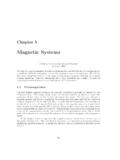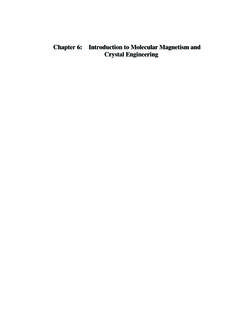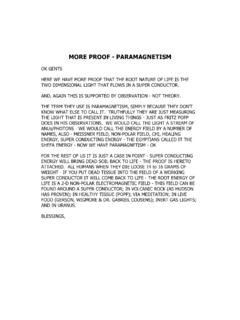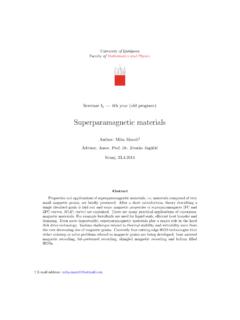Transcription of Paramagnetic Effects in NMR - University of Georgia
1 Paramagnetic Effects in NMRBCMB/CHEM 8190 April 20, 2005 Paramagnetic Effects in NMR Outline and Useful References Relaxation by electron spins distance mapping Field induced orientation RDC measurements Pseudo-contact shifts distance and angle data Solution NMR of Paramagnetic Molecules Bertini, Luchinat, Parigi, Elsevier, 2001 Useful review Bertini, I., et al. (2002). Concepts in Magnetic Resonance14: 259-286. Lanthanide chelate tags Ikegami, T., et al. (2004) J. Biomol. NMR29:339-349. Lanthanide peptide tags Wohnert, J., et al. (2003) J. Am. Chem. Centers Have Very High Magnetic Moments and Make Very Large Susceptibility ContributionsFor a single spin: = Bg (S(S+1))1/2= e(h/2 ) (S(S+1))1/2 For spins undergoing rapid transitions: eff= B2g2S(S+1) B0/ (3kT)Susceptibility contributions for averaging spins m= 0 B2g2S(S+1) / (6kT)Magnitudes about 2000 times that of protons Bis the Bohr magneton (eh/(4 me))There are Different Types of Paramagnetic RelaxationSolomon Equations Give Electron-Nucleus Dipolar Relaxation +++++++ +++ = +++++ ++ =222222226222202222222622220116)(1613)(1 4)1(4151)(1613)(1)1(4152 CSCCSICCICCSICCBMCSICCICCSICBMrSSgRrSSgR e-(S)N (I)rForm of Equation Depends on C C-1= e-1+ m-1 When electron spin relaxation is fast compared to I:eBMMTrSSgRR162222021)1(434+ == Examples.
2 S(J) C(sec)S(J) C(sec)Mn2+5/210-8Fe2+(HS)210-10Fe3+ (LS)1/210-12Co2+(HS)3/210-12Tb3+ 610-13Gd3+ 7/210-9 Nitroxide radical 1/2~10-7 Relaxation Enhancement can also Identify Interaction : Galectin Interacting with , DCCDMF, of a Spin-Labeled N-acetyllactosamineChange in 15N HSQC spectrum (800 MHz)of Galectin-3 upon addition of LacNac-TEMPO0 mM10 mMX-Ray crystal structure of Galectin-3 (Seetharamana et al. 1998)E184R186E165A245K227 Curie Relaxation Important at High FieldEven rapidly relaxing lanthanides cause population of lower spin states becomes significantThe effective moment is large and along the magnetic fieldMolecular tumbling modulates interaction with nucleiOnly R2is significant for macromolecule C= 10-8and = 5x109 +++ = ++ =2262224420220222622244202201134)3()1(45 113)3()1(451 CICCBMCICBMrkTSSgBRrkTSSgBR 1H(I)15N(S)
3 90-x 180y 90y90y t1/2t1/2 decouple180x90-x180x90-x180xt2R2for Amide protons can be Measured by Intensity Loss in HSQC SpectraProton magnetization is transverse for a total of 4 in sequenceThis is about 10 ms line with 30 Hz width looses 60% intensityRelaxation while on nitrogen is 100 times less efficientDy3+-HNDistance Mapping from PRE Paramagnetic relaxation enhancement can be approximated from intensity ratios. trcalculated from Stoke s law.)134()2()1()(Br1)4(512222242H2o62rHr rBBJoPRETkJJg +++=)ln(1wlnlPREIIt= Nitin et al (2001), Protein Science, 10, 2393-2400 Battiste and Wagner (2000), Biochemistry, 39, 5355-536515-20 20-25 Ln3+ Paramagnetic enhancement of spin relaxation:Distance mappingover 30 Provides validation of assignmentsand limits class sizesLanthanide -Tagged Hum-Q-15691 Paramagnetic Systems Give Other Complementary Information Bertini, I.
4 , et al. (2002). Concepts in Magnetic Resonance14: 259-286. PCS=112 r3[ ax(3cos2 1) rhsin2 cos2 ] PRE=15( o4 )21r6Bo2 H2(gJ B)4J2(J+1)2(2kBT)2(4 r+3 r1+ H2 r2) CCR=130( o4 )2Bo2 H2 h(gJ B)2J(J+1)rNH3kBT(3cos2 1)r3(4 r+3 r1+ H2 r2)RDC=1120 2Bo2 H hS2rNH3kBT[ ax(3cos2 1) rhsin2 cos2 ]RDCs can be Collected Without Alignment Media: Lanthanide Tagged Proteins:Ln3+ 1 2 3 Ikegami, T., et al. (2004) J. Biomol. NMR29 , J., et al. (2003) J. Am. Chem. in a Sufficiently High Magnetic Exhibit a Preferred OrientationFirst Applications were to DiamagneticsB0W = (1/ 0)(-1/2)(B0 B0)Bastiaan, Maclean, Van Zijl, Bothner-By, Ann. Rpts. NMR Spec., 19, 35-77 (1987) Paramagnetics produce much larger Effects :RDC = -( hB2)/(120 3r3kT) [ (3cos2 -1) + sin2 cos ]Note: B2dependence TROSY-HSQC correlations give RDC MHz Field-Induced AlignmentPseudo-Contact Shifts Behave Like RDCsThese Provide Additional Orientation Dataand Distance ConstraintsThe pseudo-contact shift is due to the field from an induced dipole at the Paramagnetic center.
5 This field is given by: B = u/r3 3r( )/r5We want just the field contribution in the direction of the applied field = ( )/r5= B0/(3r3)(X11 + X22 + X33) + B0/r3 ij Xij cos icos jThe first term is the isotropic shift, the second is the anisotropic second term is the same form as the RDC term. Sij= Xij(2B02/(15 u0kT), Dmax = 15 u0kT / (4 B0)Comparison of Lu3+and Dy3+ Complexes of Tagged Q15691 gives Pseudo-Contact ShiftsCharacteristicDiagonal shifts)

